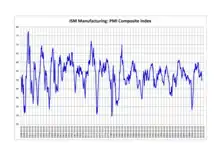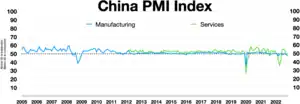Purchasing Managers' Index
Purchasing managers' indexes (PMI) are economic indicators derived from monthly surveys of private sector companies.


The three principal producers of PMIs are the Institute for Supply Management (ISM), which originated the manufacturing and non-manufacturing metrics produced for the United States, the Singapore Institute of Purchasing and Materials Management (SIPMM), which produces the Singapore PMI,[1][2][3][4][5][6][7][8] and the S&P Global (from 2022 merger with IHS Markit), which produces metrics based on ISM's work for over 30 countries worldwide.
ISM, SIPMM, and S&P separately compile purchasing managers' index (PMI) surveys on a monthly basis by polling businesses which represent the makeup of the respective business sector. ISM's surveys cover all NAICS categories. SIPMM survey covers all manufacturing sectors.[9][10][11] The S&P survey covers private sector companies, but not the public sector.
ISM began to produce the report for the United States in 1948. The surveys are released shortly after the end of the reference period. The actual release dates depend on the sector covered by the survey. Manufacturing data are generally released on the first business day of the month, followed by construction (S&P only) on the second working day, and non-manufacturing/services on the third business day. SIPMM produces the monthly bulletin since 1998 for the Singapore manufacturing sectors, with a focus on the electronics manufacturing sector since 1998.[12] The data are released on the second business day of each month.[13][14]

The Chicago-PMI survey, owned by Deutsche Börse,[15] registers manufacturing and non-manufacturing activity in the Chicago Region. Investors value this indicator because the Chicago region somewhat mirrors the United States overall in its distribution of manufacturing and non-manufacturing activity.

In 2002, SIPMM assisted China Federation of Logistics and Purchasing (CFLP) to produce the China Official PMI.[16]
ISM, SIPMM, and Markit purchasing managers indices include additional sub indices for manufacturing surveys such as new orders, employment, exports, stocks of raw materials and finished goods, prices of inputs and finished goods.[17]
Formula, calculation, and reading
PMI data are presented in the form of a diffusion index, which is calculated as follows[18]
where:
- P1 = Percentage number of answers that reported an improvement.
- P2 = Percentage number of answers that reported no change.
- P3 = Percentage number of answers that reported a deterioration.
Because of P1 + P2 + P3 = 100,
Thus, if 100% of the panel reported an improvement, the index would be 100.0. If 100% reported a deterioration, the index would be zero. If 100% of the panel saw no change, the index would be 50.0 (P2 * 0.5).
Therefore, an index reading of 50.0 means that the variable is unchanged, a number over 50.0 indicates an improvement, while anything below 50.0 suggests a decline.[19] An index of 50.0 would arise if either all respondents reported no change or the number of respondents reporting an improvement was matched by the number of respondents reporting a deterioration. The further away from 50.0 the index is, the stronger the change over the month, e.g. a reading of 55.0 points to a more frequently reported increase in a variable than a reading of 52.5.[17] The degree of confidence experienced by respondents reporting an improvement and the degree of concern experienced by respondents reporting a deterioration are not factored into the index.
Headline Manufacturing PMI
The headline manufacturing PMI is a composite of five of the survey indices.[20] These are New orders, Output, Employment, Suppliers' delivery times (inverted) and Stocks of purchases. The ISM attributes each of these variables the same weighting when calculating the overall PMI, whereas S&P uses the following weights: production (0.25), new orders (0.30), employment (0.20), supplier deliveries (0.15), and inventories (0.10).
S&P Economics' PMI surveys
The data for the index are collected through a survey of 400 purchasing managers in the manufacturing sector on five different fields, namely, new orders from customers, speed of supplier deliveries, inventories, order backlogs and employment level. Respondents can report either better, same or worse business conditions than previous months.[20] For all these fields the percentage of respondents that reported better conditions than the previous months is calculated. The five percentages are multiplied by a weighting factor (the factors adding to 1) and are added.[17]
Survey panels
Purchasing managers form a near ideal survey sample base, having access to information often denied to many other managers. Due to the nature of their job function, it is important that purchasing managers are among the first to know when trading conditions, and therefore company performance, change for the better or worse. Markit therefore uses such executives to produce data on business conditions.[17]
In each country, a panel of purchasing managers is carefully selected by Markit, designed to accurately represent the true structure of the chosen sector of the economy as determined by official data. Generally, value added data are used at two-digit SIC level, with a further breakdown by company size analysis where possible. The survey panels therefore replicate the actual economy in miniature. A weighting system is also incorporated into the survey database that weights each response by company size and the relative importance of the sector in which that company operates.[17]
Particular effort is made to achieve monthly survey response rates of around 80%, ensuring that an accurate picture of business conditions is recorded over time.[17]
Data are collected in the second half of each month via mail, email, web, fax and phone.[17]
Questionnaires
A key feature of the PMI surveys is that they ask only for factual information. They are not surveys of opinions, intentions or expectations and the data therefore represent the closest one can get to “hard data” without asking for actual figures from companies.[17]
Questions asked relate to key variables such as output, new orders, prices and employment. Questions take the form of up/down/same replies. For example, “Is your company’s output higher, the same or lower than one month ago?”[17]
Respondents are asked to take expected seasonal influences into account when considering their replies.[17]
For each main survey question, respondents are asked to provide a reason for any change on the previous month, if known. This assists not only the understanding of variable movement but also in the seasonal process when X12 cannot be used.[17]
Seasonal adjustment
The seasonal adjustment of PMI survey data is usually calculated using the X12 statistical programme of adjustment, as used by governmental statistical bodies in many developed countries. However, the X12 programme only produces satisfactory data if five years' historical data are available. In the absence of such a history of data, the PMI survey data are seasonally adjusted using an alternative method (see next paragraph), developed by Markit Economics.[17]
This method was initially designed to provide analysts with a guide to the underlying trend in the survey data and should be recognized as a second-best approach to X12. However, past experience in other countries suggests that Markit’s method of seasonal adjustment goes beyond this initial purpose and in fact in many cases outperforms X12 as a guide to comparable official data.[17]
Markit's method involves using reasons cited by responding survey panel member companies for changes in variables, which are then used to ascertain whether a reported increase or decrease in each variable reflects an underlying change in economic conditions or simply a seasonal variation. Seasonal variations may include changes in demand arising from Christmas, Easter or other public holidays. Normal, expected changes in weather are not included. The net balance of companies reporting an improvement in a variable less those reporting a deterioration is then adjusted to allow for the percentages of companies reporting seasonal induced increases or decreases in the variable.[17]
Other PMI surveys
Similar purchasing managers indices are published by the Ifo Institute for Economic Research in Germany, the Bank of Japan in Japan (Tankan), the Caixin China PMI published by Markit and the Swedish PMI run by private bank Swedbank.[21]
The Singapore PMI (新加坡采购经理指数) is published by Singapore Institute of Purchasing and Materials Management on a monthly basis.[22][23][24][25][26][27][28][29] It was developed by Professor Philip Poh. He has also contributed to the development of the Chinese PMI, and the Euro PMI.[30]
The PRIX index uses a diffusion index methodology based on that of PMIs. However, rather than drawing on purchasing managers, it uses country analysts based in the world's 20 largest oil exporting countries to forecast political events that may affect global oil exports. The PRIX index is updated quarterly and published for free on the internet.[31]
See also
References
- "Manufacturing expands for 18th straight month in February but pace of growth slows". The Straits Times. Retrieved 2 March 2018.
- "新加坡2月份PMI下滑0.4点至52.7". 联合早报. Retrieved 2 Mar 2018.
- "Singapore PMI". SIPMM Academy. Retrieved 11 March 2016.
- "Singapore PMI expands 0.3 point to 53 in March". Singapore Business Review. Retrieved 4 April 2018.
- "Singapore factory growth cools further in October amid US-China trade tensions". The Straits Times. 2 November 2018. Retrieved 3 November 2018.
- "我国11月制造业PMI连续第三个月下滑". 联合早报. Retrieved 4 December 2018.
- "Singapore's manufacturing activity eases for the 4th straight month in December". Singapore Institute of Purchasing and Materials Management. 4 January 2019. Retrieved 5 January 2019.
- "Singapore's factory activity expands for 19th month in January but at slower pace". Channel News Asia. Retrieved 5 January 2022.
- Min, Chia Yan (5 December 2017). "Singapore manufacturing shows strong signs of broad-based growth". The Straits Times. Retrieved 7 December 2017.
- "About SIPMM". Singapore Institute of Purchasing and Materials Management. Retrieved 15 June 2016.
- "Industrial Real Estate (Singapore)". DBS Bank. Retrieved 20 November 2017.
- "Key gauge of economic health due for a checkup". The Business Times. Retrieved 19 April 2008.
- "Singapore's manufacturing activity expanded at a slower rate in April". Channel NewsAsia. Retrieved 3 Feb 2018.
- "Singapore's manufacturing PMI falls to 52.7 in February". Xinhua News. Archived from the original on March 2, 2018. Retrieved 3 March 2017.
- "Chicago PMI parent finds buyer in Deutsche Börse". chicagobusiness.com. 27 June 2011. Retrieved 3 July 2017.
- "School that created S'pore's PMI looking to expand reach overseas". Today. Mediacorp Pte Ltd. Retrieved 11 March 2016.
- "PMI". www.markit.com. Retrieved 3 July 2017.
- An introduction to the PMI surveys - IHS Markit
- Randewich, Noel; Kamdar, Bansari Mayur (2022-08-23). "Wall Street ends down as investors eye slowing economy". Reuters. Retrieved 2022-09-15.
- "Purchasing Managers' Index™ (PMI™) data – FAQ | IHS Markit". ihsmarkit.com. Retrieved 2020-01-17.
- "PMI - Inköpschefsindex - konjunkturmätare".
- "Singapore PMI". SIPMM Academy. Retrieved 11 March 2016.
- Pushing the Frontier: A Cohesive System-wide Approach to Integrating ICT into Education. Springer Nature. 20 April 2017. ISBN 9789811042393. Retrieved 22 April 2017.
- "新加坡4月份制造业采购经理指数创新高". 新华网. Retrieved 7 May 2014.
- "新加坡制造业3月逆势回弹 PMI仍处50点下方". 中华人民共和国商务部. Retrieved 5 April 2016.
- "新加坡制造业连续13个月陷入萎缩". 新华丝路网. Retrieved 3 Aug 2016.
- "Singapore's manufacturing sector expands for 11th straight month in July". SIPMM. Retrieved 3 July 2017.
- "我国制造业连续11个月扩充". 联合早报. Retrieved 11 Aug 2017.
- "Singapore PMI dips in the new year, echoing slowdown seen across Asia". The Business Times. Retrieved 5 January 2022.
- "Key gauge of economic health due for a checkup". The Business Times. Retrieved 19 April 2008.
- "PRIX".